Pier to pier aboard PS Waverley
Pier to pier aboard PS Waverley
Written by Dr Rhoda Ballinger, SEP Chair
A voyage of discovery on the Estuary involving bridges, mountains of chips and even Tracey Island!
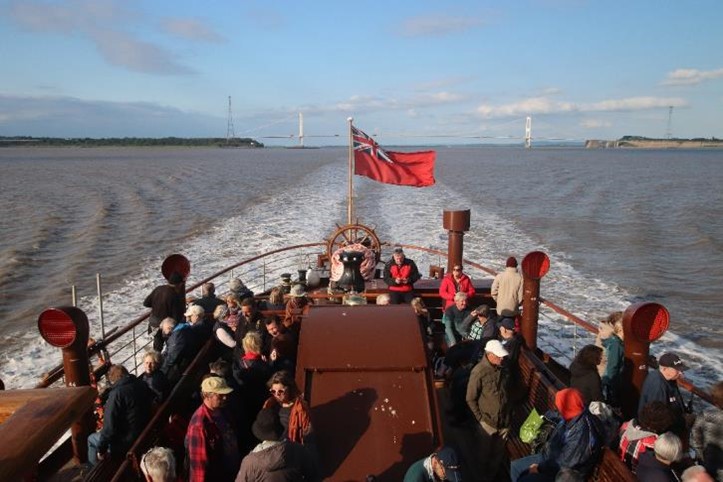
What better way to explore the estuary, but aboard the famous paddle-steamer PS Waverley for a rare chance to cruise under the bridges. Join me and my travel companion, visual artist Heather Green, on our half-day cruise to discover more about this wonderful vessel, the last ocean-going paddle steamer in the world, and to learn about some of the delights of sailing in this dynamic, tidally dominated environment.
The PS Waverley – the star of the show?
Sleek and graceful, the recently refurbished PS Waverley glid across the grey sea towards Penarth Pier, watched and photographed by an almost silent, expectant crowd of onlookers. Clearly, the long-standing tradition and popularity of leisure paddle steamers in the Bristol Channel is still alive! Despite being dwarfed by the pier, the Waverley herself promised to be the star of the cruise with her handsome red funnels, well-polished decks and nostalgic charm. There were few thoughts of the possible fragility of such an old vessel, reliant on, what I later discovered, was eighteen century technology – the first ever paddle steamer appears to have been built in France to sail the Doubs.
Once settled onboard, I took an obligatory visit to the recently restored engine to admire this gleaming, mighty piece of engineering on which we would depend to carry us safely and swiftly through the potentially treacherous waters of the upper estuary. Standing among a throng of awe-struck onlookers, we all watched intently as the pistons moved back and forth, providing a reassuring and regular clunking accompaniment, seemingly from a by-gone age. Although the paddles themselves are now largely obscured, their flickering shadows were just visible through misted-up glass windowpanes.
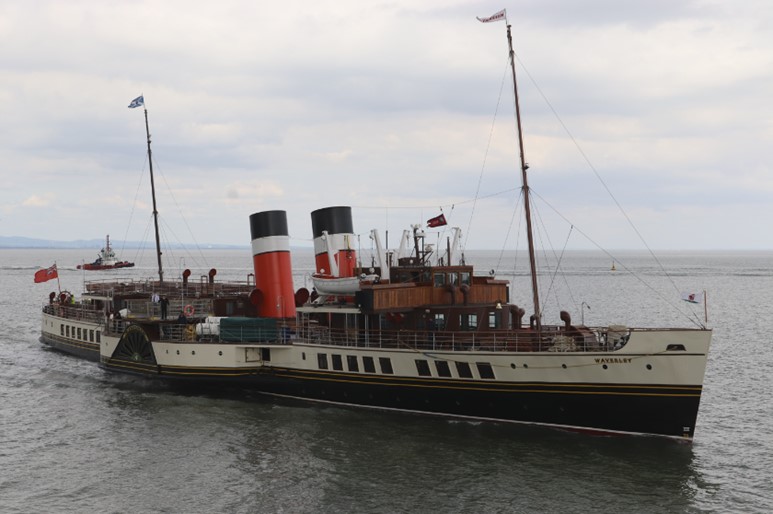
PS Waverley approaching Penarth
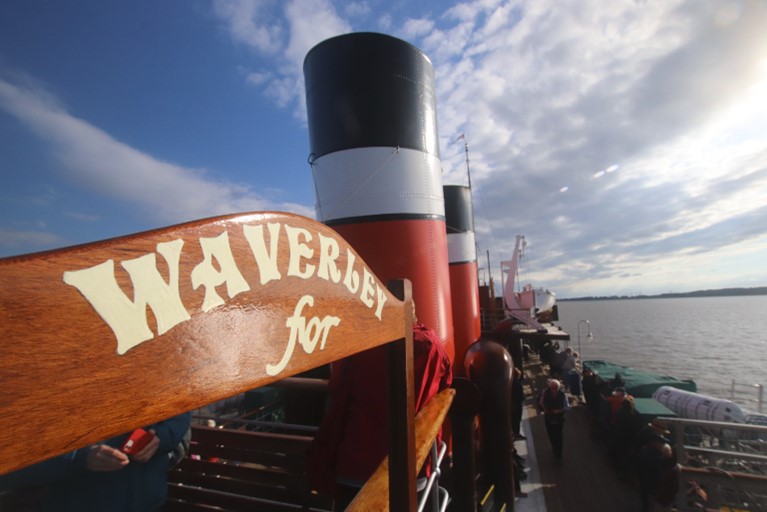
A glimpse of the maritime charm of PS Waverley
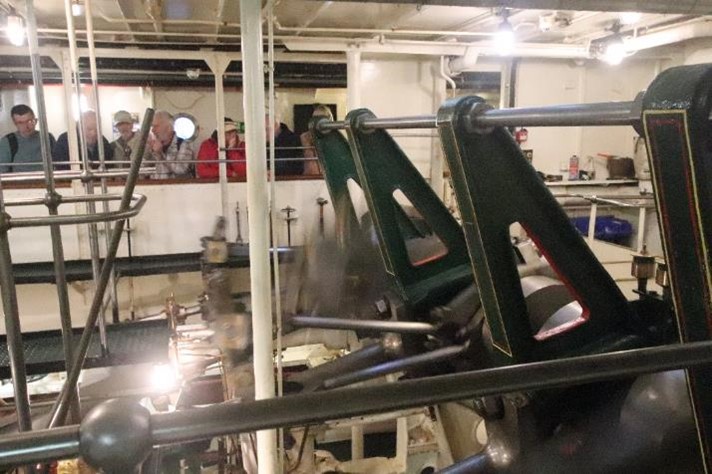
Waverley’s engine being admired by keen onlookers
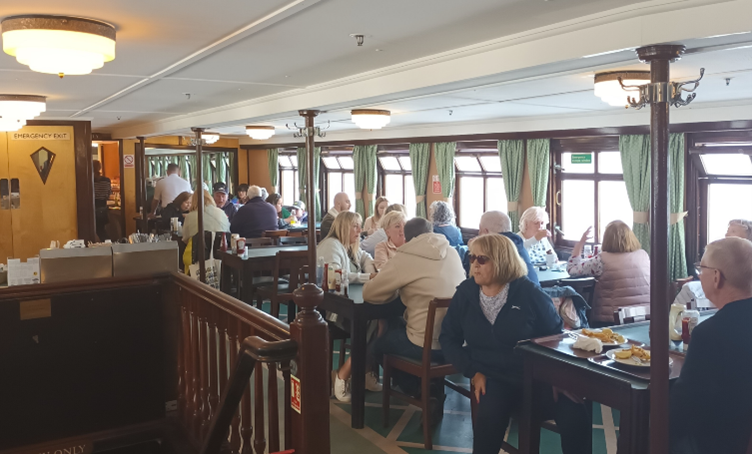
The elegant dining saloon
KEY FACTS ABOUT PS WAVERLEY: Built in 1946 by Inglis in Glasgow, it is now the last seagoing paddle steamer in the world, listed within the UK National Historic Fleet as “a vessel of pre-eminent national importance”. It is powered by a three-crank diagonal triple-expansion marine steam engine. The Waverley underwent a major £7m rebuild in 2000 and 2003. For technical details from the Paddle Steamer Preservation Society, click here.
Despite our excellent viewing position on the aft of the observation deck, we eventually ended up, along with what seemed to be nearly everyone else onboard, in the restaurant, not only to warm up and to partake of traditional refreshments (yes, chips were involved), but also to rediscover the nostalgic charm of this art deco dining saloon with its fine wood panelling and elegant ceiling-mounted glass lights. We were also delighted by the different aspect afforded by the low perspective of the wide saloon windows as we waited reasonably patiently for our evening meal. The charms of the wood panelling did, however, being to fade as we waited SO long, trying not to stare at the mountains of chips being devoured by fellow passengers.

The offshore perspective
As I’m sure you’ll have experienced – one of the fascinations of a cruise is to see your surrounds from a different angle. Earlier in the day, as we swept out into the Channel, swiftly leaving the pier behind, the scale, openness and expanse of the offshore quickly began to dominate – new geographies of the islands and coast constantly emerged as the resorts and cities which hug the shores receded into the distance. Would we glimpse the ‘dark side of Steep Holme?’ anxiously asked one passenger – well, no, but we would be treated to lots of photographic opportunities and the full range of Severn Shades of grey, green, blue and brown, worthy of a Farrow and Ball or Little Greene colour card, certainly not just the ‘grey-brown’ offered by Peter Finch in his recent book ‘Edging the Estuary’.
A running commentary pointed out key historical landmarks and other attractions along the way. We learnt lots of new facts about the former and current uses of the coast. Did you know that there was a nautical college at Portishead, the National Nautical School which, had been created for ‘destitute, neglected and often delinquent boys from Bristol, but which now, like many other imposing buildings with a sea view, has been converted to residential apartments? Are you aware that there is a tanker storage facility on the coast close to Portishead which supplies Gatwick with aviation fuel?! Have a look at these online photos to see the scale of this impressive site which was constructed as a Government Civil Reserve in the mid-1950s by ESSO. I’m sure many of you who have driven along the M5 will be aware that Bristol Port has hectares of vehicle storage but you may be less aware of the large number of giant onshore wind turbines along the waterfront here. Certainly, the marine perspective offers new glimpses into our estuary’s frequently hidden shores.
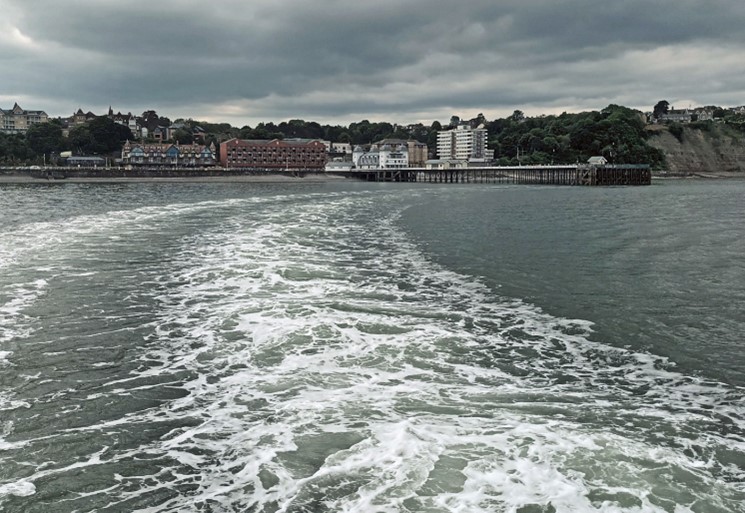
Penarth receding into the distance behind the ship’s wake
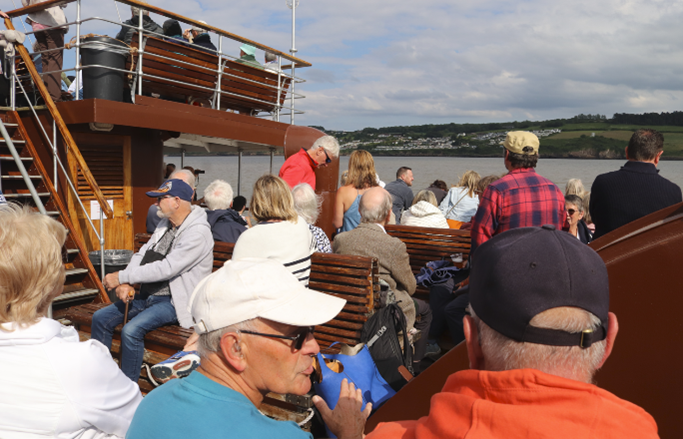
Passengers on deck sampling the delights of a Waverley cruise
Interesting as the commentary was, neither this, nor indeed, the curious offshore views, managed to entertain certain of the few younger passengers onboard. There was a plaintiff ‘are we nearly there yet?’ query from a very small traveller nearby, merely five minutes after embarking. Enterprising parents quickly devised a game of eye-spy buoy bingo and we were well entertained listening to many excited exclamations, as buoys of various shapes, sizes and colours were spied. However, as the game progressed, we were very much aware of the youngsters’ and parent’s confusion as the parent attempted to respond to the question, ‘if that’s a ‘boy’ then where are ‘men?’ May be an opportunity for future educational cruises and commentaries? There may also be a possible role for SEP to supply further information on the natural environment for future cruises? All good stuff in the commentary, but sadly no information about the natural environment, nor in any of the many available purchases in the ship’s tiny onboard shop.
Engineering connections – bridges and piers
If the intensity of the clicking of mobile phones and SLR cameras was an indicator of passenger interest, then the piers and bridges were certainly the main acts. No surprise perhaps given both Penarth and Clevedon piers are rightly celebrated and have been so over much of the last century: indeed, the poet Sir John Betjeman considered Clevedon Pier ‘the most beautiful in England’ and more recently, in a 2024 National Trust survey, Penarth Pier was voted ‘the most special place in Wales’. Even on a somewhat grey dull day, the elegance of the art deco ironwork on Penarth Pier and the Japanese-style pagoda at the Pierhead on Clevedon Pier, was immediately apparent. However, the sheer size, design and strength of the ‘undercarriage’ of both piers was their most impressive feature, as we peered up at them from the deck of the Waverley. Even more amazing was thinking about the perilous construction of these structures in the first place, in such an inhospitable environment and with relatively simple technology – I learnt afterwards that, not surprisingly, the first attempt to build Clevedon Pier, as early as 1837, had been thwarted by rough seas, causing the structure to collapse. As we watched the volunteers supporting passengers onto the vessel at Clevedon and Portishead, I was also reminded of the immensely impressive community endeavours associated with these structures. Over many, many decades, local communities have come together to fight and raise money for the restoration and maintenance of these notable landmarks, frequently and seemingly sometimes against the odds, in the aftermath of various storms, natural and economic. What was evident on our short trip was that this community spirit continues. Even onboard, as passengers from all embarkation points mingled and shared their experiences in a fascinating range of regional accents, new connections were visibly and audibly being fostered across the Estuary.
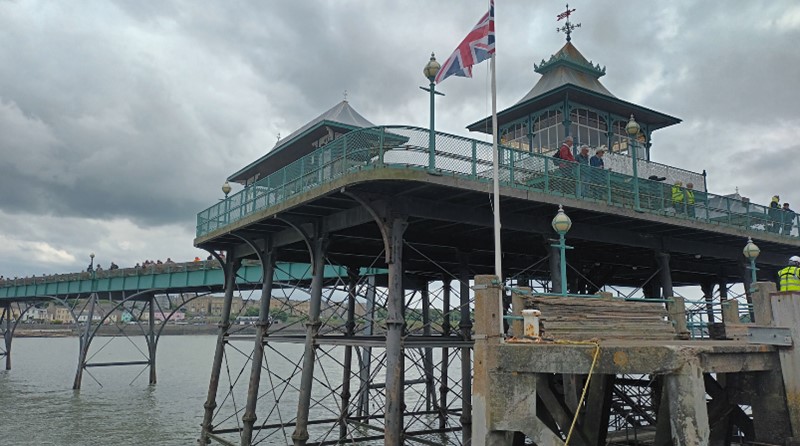
Clevedon Pier from the deck of PS Waverley

KEY FACTS ABOUT CLEVEDON PIER: 310m long and with 4.3m clearance at high water. The pier opened on Easter Monday, 29th March 1869. It helped provide a new, fast route to S Wales until the Severn Railway Bridge Tunnel opened in 1886. The pagoda and shelters were added in 1894, fashioned on Nash’s Brighton Pavilion. 1970 saw the dramatic collapse of part of the pier. ‘Vocal local support, heritage engineering expertise and lottery funding‘ enabled the Pier to be voted ‘Pier of the Year’ in 1999! The pier has Grade 1 listed status.
KEY FACTS ABOUT PENARTH PIER: At just 200m long, the pier allows shipping access into Cardiff Docks. It was opened to the public in February 1895. The art-deco style pavilion on the landward side was opened on 18 May 1929. An original wooden pavilion on the seaward end was destroyed by a fire in 1931. The pier was closed for repair work for two years after a ship crashed into it in a gale in 1947. Following some difficult years, various restoration programmes resulted in the Pier voted ‘Pier of the Year’ in 2014! The Pier has Grade 2 listed status.
Even though most of us must have crossed both Severn bridges innumerable times before, to sail under them offers a new perspective on the old and familiar, and in this respect the cruise certainly didn’t disappoint. Indeed, as we sailed under these massive structures and their mighty supports were revealed, the onboard excitement was palpable. Surprisingly, there was no audible cheer – only the ship’s horn broke the relative silence on deck as we finally emerged upstream of the old Severn Bridge. There was then a flurry of activity onboard as people pointed SLRs and mobiles toward the bridges to capture that precious moment, and to take the inevitable selfie. Whilst neither bridge may not be as long or as high as other notable bridges in the UK, these elegant structures are integral to our estuary’s identity and, as such, should be celebrated. Indeed, the Severn Bridge still is the central feature of our own, Severn Estuary Partnership’s logo.
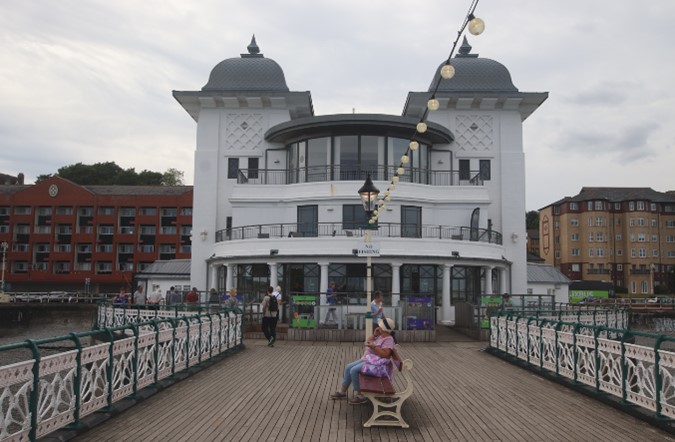
The ‘new’ pavilion on Penarth Pier
The bridges not only provide vital connections for modern day society but are also significant feats of engineering, particularly given the underlying geology and tidal currents in the intervening stretch of water. I can remember coming back from SEP meetings and crossing the ‘old’ Severn Bridge back in the 90s, and wondering at the seemingly slow placement of pillar supports for the ‘new crossing’ – would they ever get to the other side? It took four years, but I can vouch from my brief inspection of the underneath of the bridge, that it’s a very solid piece of engineering and does span the entire estuary! Apparently too, this bridge has been built to withstand an earthquake or, indeed, a ship collision – the tragic fate of the railway bridge over the Severn at Sharpness. More about all these bridges in subsequent postings!
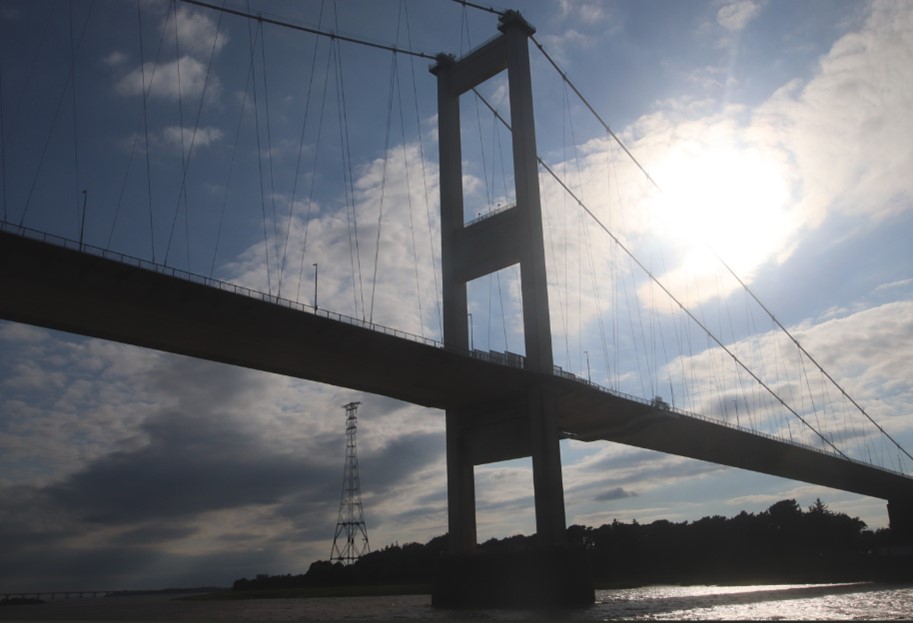
A Severn Bridge pillar from below
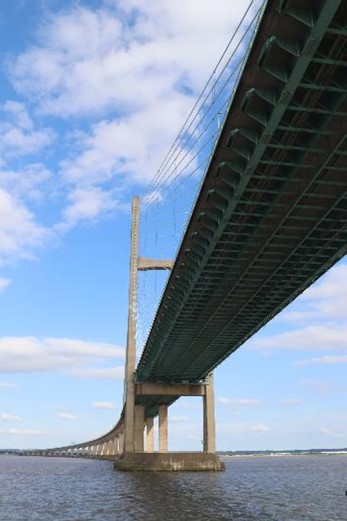
A novel perspective – the Prince of Wales Bridge from below

Surprisingly, a few passengers were almost more impressed with other nearby attractions than the bridges themselves. The Old Ferry Slipway at Beachley drew quite a crowd of onlookers, but it was the ‘That’s it – Tracey Island!’ exclamation from a nearby passenger which was most unexpected. Seemingly, Chapel Rock resembles the famous Thunderbirds’ island and has been a landmark and useful distraction for some young families for many years! Researching the island, it’s actually quite a significant feature in its own right, although from the deck of the Waverley it didn’t really look much. The island, which has had no fewer than four names, apparently, attracted pilgrims and saints from far afield, or, should I say, afloat, back in the day. More about these Celtic connections in future walks, I think.
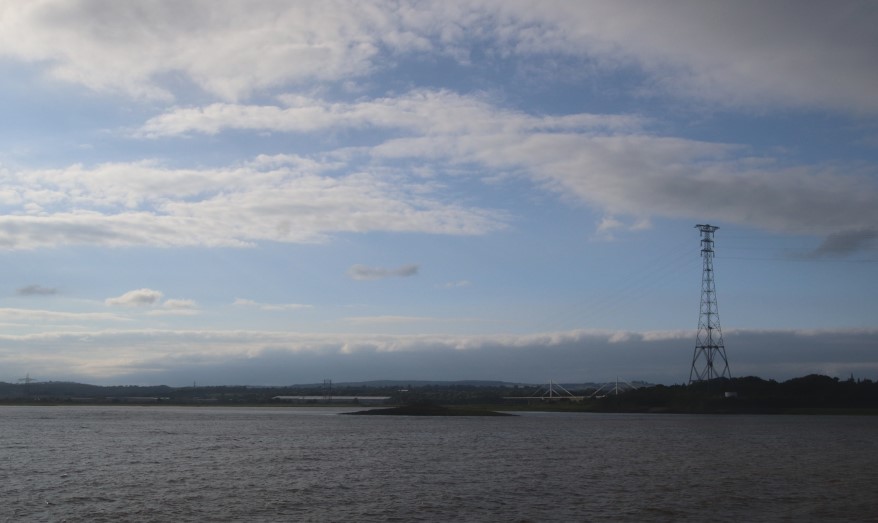
A rare sighting of Tracey Island from offshore!
Tidal waters run deep (just deep enough)
The perils of navigating the tidal currents and the constantly varying water depths of the estuary were obvious from the start of our voyage. When we were ushered quickly onboard at Penarth, it was that ‘time and tide’ were certainly not going to wait for anyone, not even the most iconic of historic ships, even one which has a relatively flat hull and a draft of only 1.9 metres.
There were also frequent references to the ever-changing tidal state of the estuary in the commentary too, particularly as we approached the upper estuary and sailed between and under the bridges. Taking onboard pilots to help our safe passage, we wound our way in what at first appeared to be a most bizarre route, to follow the deeper tidal channels between and under the bridges. I briefly reflected about the geomorphological history of the Severn and wondered at the origins of these ancient river channels, as well as the human endeavours to chart these precarious waters.
There were further reminders of tides later on in our cruise. As we disembarked at Penarth there was a somewhat anxious and then forceful request for the remaining passengers going on to Clevedon to move to starboard. This was the point where I hoped the earlier intake of chips by some of the passengers would pay dividends! The ship then very gently tilted over slightly, enabling us to climb the now steep gangway. Would we all make it? Assistance was indeed required for some of the more elderly clientele, but fortunately this time, at least, we all did alight onto the pier! Hopefully, all the remaining passengers also caught the tide at Clevedon later in the evening. This all reminded me of a couple of previous Severn Estuary cruises. There was the cruise which followed a previous Severn Estuary Forum when packed lunches were almost thrown at forum delegates as they were ushered with great haste out of the Penarth Paget Rooms and down to the pier to alight the MV Balmoral. There was also a slightly less happy memory – being stranded for many hours offshore and sampling much of the ship restaurant’s menu as we waited for the tide to oblige and let us disembark at Penarth!
Conclusions and further thoughts
So, overall, despite the final somewhat undignified climb, a great day out in the Estuary! We might not have seen the dramatic cliffs of the North Devon coast or, indeed, the wildlife around Lundy, but it was a memorable, even if rather chilly experience. I’m already looking forward to the 2025 cruise season, hoping that SEP might be able to team up with the Waverley to input some more information about the natural wonders of the Estuary into their cruises and associated paraphernalia, particularly given some passengers’ comments about the need to go to Cornwall to see any marine life. Looking to future seasons, there’s also the possibility that the much-loved and most widely travelled excursion ship, MS Balmoral may join the Waverley if further funding for restoration allows. Beyond that, the ongoing refurbishment of 1867 Birnbeck Pier to future public use may, hopefully, eventually inspire further restoration of this listed structure to provide a new ‘port of call’ for cruises. Whilst we’re not likely to get back to the heyday of steam paddlers on the Bristol Channel, when supposedly over 15,000 people per day disembarked at Birnbeck, if the comments of our fellow passengers were to believed, there’s definitely an appetite for recapturing the nostalgia associated with the historic steam paddlers of the Bristol Channel. For me in the short-term, however, this short cruise has been a useful window on the Estuary and a reminder of all the stretches of shore still to be explored in my future walks!
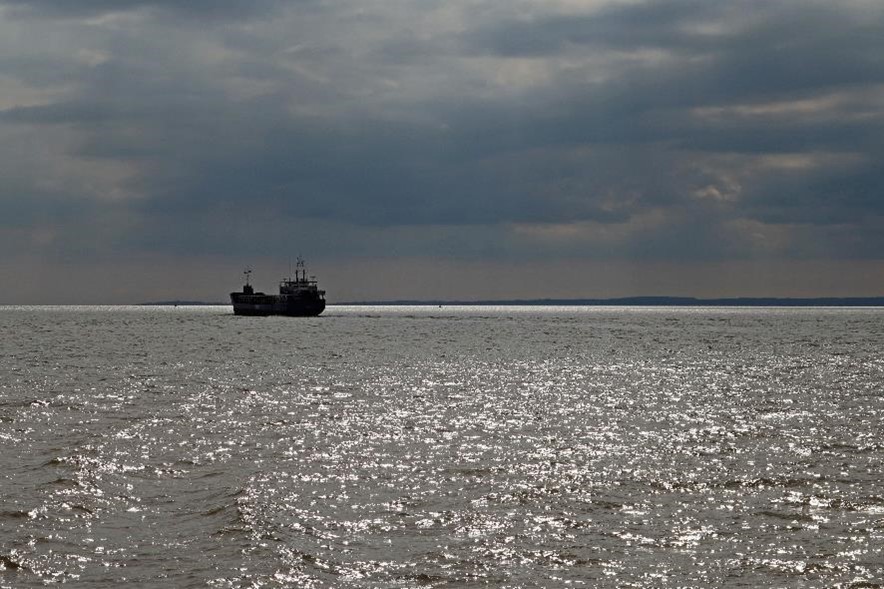
A shipping navigating the tidal waters of the Estuary

Self, onboard the Waverley

Do you have memories of cruising on the Bristol Channel? Let us know if you have memories you’d like to share.
More to explore
Paddle Steamers in the Bristol Channel
The Piers

 Severn Estuary Partnership
Severn Estuary Partnership